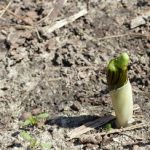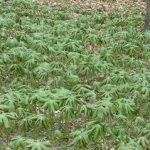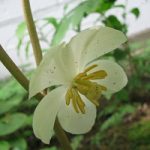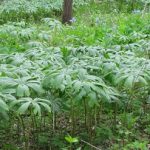Early each spring we look forward to the appearance of hundreds of Mayapples in our small woods. They appear like magic, usually after a few warm April days. Only a couple of days after their first shoots poke through the ground our woods are carpeted with umbrella-like Mayapple leaves.
It’s too bad that the Mayapple is misnamed. In most parts of its range, from Florida to Quebec and west to the Great Plains, it starts growing in early spring, flowers in May, and produces “apples” in June or early July. So, perhaps it should be called Mayflower or Juneapple.
Mayapples love living in the dappled sunlight in open forests. They spread by rhizomes and occasionally creep out into sunny areas and into deeper, darker woods. One of the delights of this plant is how easy it is to identify. No other North American wildflower sports the large umbrella like leaves that often appear in large patches.
When we look closely at our Mayapple patch we notice that most are leafy umbrellas rising on a single stalk while some are forked with a stem that splits like a “Y” and sporting two umbrellas.
In May, these double leafed stems each grow one gorgeous but easy to miss white flower that’s usually pollinated by bumblebees. The flowers are easy to miss, because they are shaded by the large leaves.
The flower grows into a green fruit that looks like a mini lemon. It gradually turns yellow as it ripens.
All parts of this plant are toxic including the green fruit. However, once the fruit turns yellow it becomes edible and may people enjoy its custard-like fruit. But, be cautious. If eating it for the first time just enjoy a tiny portion of the yellow fruit to make sure it agrees with your system. Always be certain your identification is correct. A reliable source of information on many plant species, including Mayapple is United States Department of Agriculture, Natural Resources Conservation Service. Enter the name of the plant being sought, using either common or scientific name.
Mayapples create a beautiful ground cover in open woods. They are easy to establish. Dig a few roots from a large patch and plant them under the trees. They’ll spread by rhizome.





